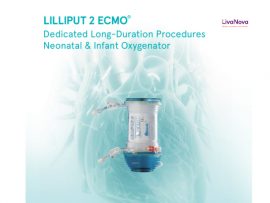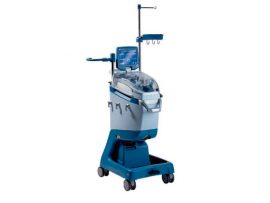Abstract Background Primary malignant cardiac tumors are rare in clinic, and surgical resection under cardiopulmonary bypass (CPB) remains the main treatment. The non-physiological perfusion process of CPB leads to contact activation,..
WeiterlesenAbstract Introduction Over the past decade, there has been an increase in the use of recombinant Anti-Thrombin III (AT-III) administration during neonatal and pediatric short- and long-term mechanical support for..
WeiterlesenAbstract Background Extracorporeal membrane oxygenation (ECMO) is a rescue therapy in patients with severe acute res‑piratory distress syndrome (ARDS) secondary to COVID‑19. While bleeding and thrombosis complicate ECMO, theseevents may..
WeiterlesenAbstract Extracorporeal membrane oxygenation (ECMO) is a form of cardiorespiratory support, and is being increasingly used to support refractory heart and respiratory failure. It involves draining blood from the vascular..
WeiterlesenAbstract Objectives To investigate the effect of retrograde autologous priming (RAP) on coagulation function using rotation thromboelastometry (ROTEM) in patients undergoing valvular cardiac surgery. Design A prospective, randomized, patient- and outcome assessor-blinded study...
WeiterlesenAbstract Anticoagulation for Subclinical Atrial Fibrillation Recently, the ARTESIA study addressed this question in a randomized trial of 4,012 patients with subclinical atrial fibrillation identified by an implanted device, and..
WeiterlesenAbstract Introduction Extracorporeal membrane oxygenation (ECMO) may act as a driver or propagator of systemic inflammation. In turn, cytokine release can modify thromboelastographic (TEG) tests which are commonly used for..
WeiterlesenAbstract Introduction Due to the risk of thrombosis, nearly all children supported by extracorporeal membrane oxygenation (ECMO) receive systemic anticoagulation. While heparin has traditionally been used, there are reports of..
WeiterlesenAbstract Extracorporeal Membrane Oxygenation (ECMO) is a technology that offers organ support for critically ill patients with respiratory and/or cardiac failure. Despite improvements in recent years in technology and the..
WeiterlesenAbstract Background: The conventional method of heparin and protamine management during cardiopulmonary bypass (CPB) is based on total body weight which fails to account for the heterogeneous response to heparin in each patient...
WeiterlesenAbstract Background This study investigated whether intraoperative blood salvage was associated with coagulation disorder diagnosed by conventional coagulation tests and thromboelastography (TEG) after cardiopulmonary bypass (CPB). Study design and methods..
WeiterlesenAbstract Background Bleeding after cardiac surgery is common and continues to require 10–20% of the national blood supply. Transfusion of allogeneic blood is associated with increased morbidity and mortality. Excessive..
WeiterlesenAbstract This article introduces an open-source tool to experimentally compare blood residence time in biomedical devices using an image-based method. The experimental setup and the postprocessing workflow are comprehensively elucidated..
WeiterlesenAbstract Ensuring adequate anticoagulation for patients requiring cardiac surgery and cardiopulmonary bypass (CPB) is important due to the adverse consequences of inadequate anticoagulation with respect to bleeding and thrombosis. When..
WeiterlesenAbstract Background Unfractionated heparin (UFH) is commonly used during cardiac surgery with a cardiopulmonary bypass to prevent blood clotting. However, empirical administration of UFH leads to variable responses. Pharmacokinetic and..
WeiterlesenAbstract Background Bleeding and thrombotic complications compromise outcomes in patients undergoing percutaneous mechanical circulatory support (pMCS) with veno-arterial extracorporeal membrane oxygenation (V-A ECMO) and/or microaxial flow pumps like the Impella™...
WeiterlesenAbstract Hemostatic devices are critical for managing emergent severe bleeding. With the increased use of anticoagulant therapy, there is a need for next-generation hemostats. We rationalized that a hemostat with..
WeiterlesenAbstract Background Intraoperative pulmonary embolism (PE) with cardiac arrest (CA) represents a critical and potentially fatal condition. Available treatments include systemic thrombolysis, catheter-based thrombus fragmentation or aspiration, and surgical embolectomy...
WeiterlesenAbstract Introduction: The optimal timing for extracorporeal membrane oxygenation (ECMO) circuit change-out is crucial for the successful management of patients with severe cardiopulmonary failure. This comprehensive review examines the various..
WeiterlesenAbstract Microfluidic membrane oxygenators are designed to mimic branching vasculature of the native lung during extracorporeal lung support. To date, scaling of such devices to achieve clinically relevant blood flow..
WeiterlesenAbstract Introduction The point-of-care test (POCT) is useful for blood coagulation management during cardiovascular surgery. Although thromboelastography (TEG6s) has been reported to have targeted benefits for blood transfusion in cardiac..
WeiterlesenAbstract Purpose For pediatric patients, extracorporeal membrane oxygenation (ECMO) remains the predominant mechanical circulatory support (MCS) modality for heart failure (HF) although survival to discharge rates remain between 50 and..
WeiterlesenAbstract Extracorporeal membrane oxygenation (ECMO) provides temporary cardiorespiratory support for neonatal, pediatric, and adult patients when traditional management has failed. This lifesaving therapy has intrinsic risks, including the development of..
WeiterlesenAbstract Introduction Heparin is the primary anticoagulant for cardiopulmonary bypass (CPB) support during cardiac surgery. While widely used, ∼2% of cardiac surgery patients develop heparin-induced thrombocytopenia (HIT) and 4–26% develop..
WeiterlesenAbstract Background No guidelines for administering and monitoring anticoagulants intraprocedurally are currently available in dogs, despite the prevalence of procedures necessitating systemic anticoagulation with heparin. Objectives To evaluate an activated..
WeiterlesenAbstract OBJECTIVES The use of cardiopulmonary bypass (CPB) in cardiac surgery is a major risk factor for postoperative bleeding. We hypothesized that consumptive coagulopathy and haemodilution influence the coagulation factors;..
WeiterlesenAbstract Introduction Individualized heparin and protamine management is increasingly used as a strategy to reduce coagulation activation and bleeding complications. While it is associated with increased heparin requirements during Cardiopulmonary..
WeiterlesenAbstract Background Nitric oxide (NO) is a gas naturally produced by the human body that plays an important physiological role. Specifically, it binds guanylyl cyclase to induce smooth muscle relaxation...
WeiterlesenAbstract Background Heparin resistance is a common complication of surgical patients requiring anticoagulation, such as those undergoing cardiopulmonary bypass (CPB). Treatments to address heparin resistance include supplementation of antithrombin (AT)..
WeiterlesenAbstract Introduction The objective of this study was to investigate the potential synergistic utility of a combination of gaseous nitric oxide (gNO)-intravenous Cangrelor as an effective pharmacological option for the..
Weiterlesen










